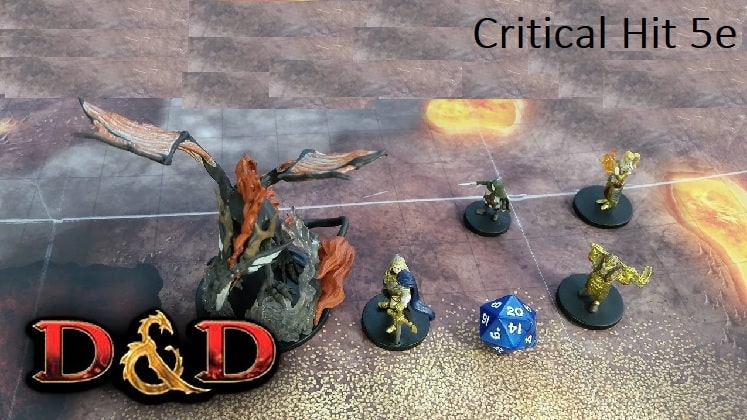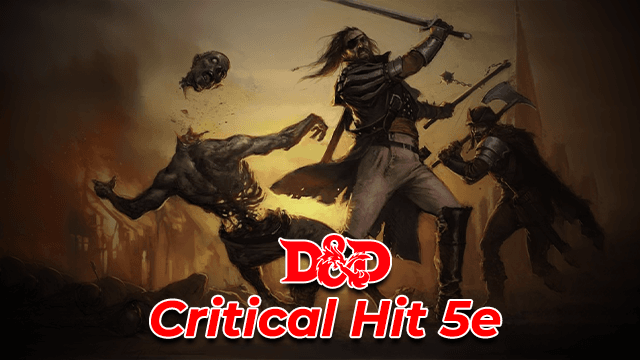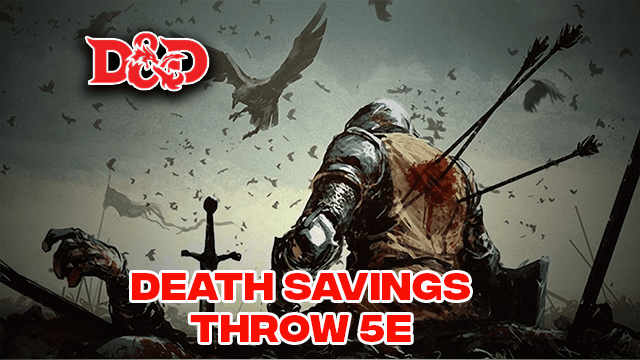Critical Hit 5e & Damage Work Guide in DnD 5e -(2023)
The DND critical hit and “crit” are frequently used, but if you’re familiar with the game, you may well not know what they’re saying or what they signify. Don’t fear. It’s a simple concept, though this post will explain everything to you if you’re confused.
Table of Contents
What Does DND Critical Hit mean?
Whenever you throw a d20 score a hit, this is regarded as a “clean 20” but is a direct hit (or crit). After tossing and applying your modifiers, you obtain a sum of 20. It is known as a ‘clean 20’ because it has no having responsibilities. A critical always will strike, regardless of your enemy’s AC.
If you score a critical hit dnd, you’ve delivered a mighty strike, which is symbolized either by the victim taking extra damage. A critical hit dnd twice the score of all rolls in action, but not the damage score. So, if a Fighter with a +3 Str gets a crucial hit along with a small sword, the result is 2d6+3.
Is it necessary to crit with a 20?
No, not at all! Some skills in the game allow you to crit on a 19th level. It handles as if one throws a 20, which means you hit and get double damage dice.

What is a critical Miss?
- A critical miss on an attack roll is the same as an acute failure.
- RANGED Strikes Excluded if you have an Effective Defence that scores a Critical Success against you.
- A Critical Miss Chart on B446 applies to major fails on armed hits/parries. In contrast, a Disarmed Critical Missed Table applies to unarmed hits/parries in 4e.
- The UCMTs for GURPS Martial Arts in 3e was “Stunning and Feinting” on page 68 and “Grappling, Locks, and Throws” on page 69.
Critical Hit 5e: How Do They Work?
You get a critical hit 5e when you dice a spontaneous 20 on a safety net break in DND 5e. It indicates you scored a 20 with no adjustments applied, such as your attack modifier.
We’ll come back to the very last portion of that later.
Critical hits are a battle feature in DND 5e that indicates a monster delivering a direct strike to its target.
What is the Purpose of a Crit?
Critical strikes in DND 5e imply you achieve your goal (independent of its Armor class) and roll twice as many damaged dice. The type of die changes depending on the weapon.
- Die a natural 20; instead of the usual 1d8, you’ll cast both interlock dice (2d8) for harm.
- Quadruple your damage modifier.
- Apply standard damage modifier to the total.
- Usually, crits hit and multiply the damage dice.
- You’ll recover one hit bar and come back to life after that.
When attacking in 5th Edition D&D, a high roll on a d20 alone qualifies as a “critical.” However, throwing a 20 feels fantastic! So, it’s a bummer if you die a 20 and don’t gain some mechanical advantage.
Many people have debated the advantages (and disadvantages) of implementing measures in other game areas. The debate misses the forest through the trees; because you should not ask for a talent check that a person can’t pass, a 20 must always be considered successful.
Now, I’m not opposed to having a little narrative flavor, but bringing the narrative home without some mechanical bite is challenging. All you got for your $20 was a few more fancy words.
Imagine if there were some throws that participants had to take that could benefit from a little more mechanical bite to prevent the 20 from feeling “wasted”? There’s one type of roll, at least. And there are already some critical wins!
Throws to save the game
I’m referring to saving throws! The players must create them. When you roll a 20 instead of a 19, they gain no advantage.
Throws that save your life
Surprisingly, this mechanic is in the game. If you score a 20 on a funeral overcoming throw, you recover 1 HP.
Critical saves
We can apply rewards like these to regular saving throws to restore part of the thrill of rolling a 20! The Hide action 5e is often used in battle to make a Dexterity test. If the hero passes this test, they will gain the invisible fighter reputation, both offensively and defensively.
Fumbles save
We have blunders on the other side of the equation (rolling a 1). But I’m not a fan of adding physical fangs to mistakes (because they penalize skilled players more). Rescue throw errors don’t have the same multi-attack issues as assault fumbles.
So, if we are including save fumbles in your game, I recommend restoring critical! What’s going on here? You missed scoring a physical attack and rolling double the harm died when you chose a hex with a resistance attempt rather than a spell attack. When a creature rolls a critical miss on a save, apply twice harm (dice).
Dnd Critical Hit Basic Rules
- As you’ll see, dnd critical hits are the highest possible d20 rolls, while critical misses counterbalance necessary losses.
- Whenever a d20 is throwing for an assault, the rules state that critical strikes occur.
- Keep in mind that spells count as attack rolls.
- Since sword strikes are relatively frequent than magic attacks, critical hits are more familiar with hit points, but magic vital occur.
- We did not just hit your designated destination when you score a critical hit 5e, but you deal double harm.
- You can only double in the number of dice you roll; nothing extra flat mods are permitted.
- With an assault roll, you would double the number of dice that roll for spells.
- Once you are to 0 hit counts in DND 5e, you should make three particular fighting attempts.
- If all three saving throws are successful, you will settle and not die.
- Dying saving attempts are among the most crucial dice you’ll ever make during your Dungeons & Dragons career.
- Among the few elements that affect such saving attempts is dnd critical hits.
Is it true that a 5e critical hit doubles the power of a sneak attack?
One of the most asked questions about critical damage that which damage dice gets tripled. It is frequent among new players, as well as someone who is to a 3.5/Explorer system.
5e Critical hit in that method quadruple the number of primary weapons damaging dice and all modifications (which may quickly add up!) but don’t involve any other die in the damage roll.
However, DND 5e is different. All harm dice directly tied to the score are in return for bonuses. Stealth attack damaging dice, Nuke health dice, and any extra attack dice from abilities like Thriving Sword always are double.
Additional dice from your weapons are also double, including such house fires from a Flaming blade.
Occasionally, an effect or weapons capability will only activate if you get a critical hit 5e, which will add healing die to your pools.
Whenever a talent says something such as “Whenever this weapon lands a physical attack, it deals an extra 1d4 force damage,” it means a 5e critical hit doesn’t compound the additional 1d4.
That’s because the damage isn’t part of the assault; instead, it gets triggered by one of the attack’s qualities.
Conclusion
Combat is brutal enough for newcomers to Dungeons & Dragons Fifth Edition. Then you strike it rich and start landing dnd critical hit. You now have to deal with an altogether another mechanism.
Faqs
“You have to roll additional dice for such attack’s harm against by the target if you score a physical attack….” To put it differently, significant strikes in DND 5e imply you achieve your goal and roll twice as many poisons dice. The type of die differs depending on the weapon. 26-Apr-2022
In 5e, there seem to be three methods to score a critical hit. One would be to cut a 20 on an assault roll. Which is a guaranteed hit irrespective of opponent AC or assailant’s strike advantage or punishment. The next is comparable but not identical to the first.
When you achieve a physical attack, you have a second opportunity to screw the attack’s damaging dice. If the assault uses extra rolls (from a characteristic like Orcish Rage or Stealth Attack), you must roll them again.
There will be only one crucial hit criterion: multiplied by all other damaging dice used in the assault. The Huge Poisonous Snake’s deadly attack die inextricably linked to the assault score of the Attack act.







